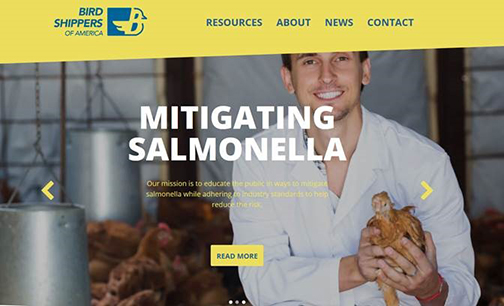Hatcheries work with CDC to teach customers how to prevent human Salmonella infections from backyard flocks

Privett Hatchery sends out CDC fliers with all orders of backyard poultry to help educate consumers about ways to prevent Salmonella. In this photo, 25,000 copies of educational fliers are boxed and ready to go with orders. This flier can be seen on the Healthy Families and Flocks page.
When it comes to getting sick from Salmonella infections, many blame food. While Salmonella often spreads when people eat or mishandle contaminated foods, the bacteria can also spread through animal contact.
Not washing hands after contact with live chickens and ducks in backyard flocks can cause Salmonella infections in people, and outbreaks of infections linked to backyard flocks have increased over the past few years. In fact, the largest number of such illnesses ever recorded in the United States occurred in 2017, with over 1,000 sick people in 10 multistate outbreaks. In 2018, CDC and multiple states continue to investigate several multistate outbreaks of Salmonella infections linked to live poultry, with 212 illnesses in 44 states reported during the first half of the year alone.
To keep customers and workers safe, CDC initiated partnerships with hatcheries across the country to take action to prevent Salmonella infections and better educate customers. These partner efforts teach customers to:
- always wash their hands thoroughly after touching live poultry;
- not allow children younger than 5 to touch live poultry without adult supervision;
- set aside a pair of shoes to wear while taking care of birds that are kept outside the home, and to not let live poultry inside the house.
Several businesses use CDC materials to help educate their customers. A hatchery in Iowa works with other mail-order hatcheries around the country to host a common website, which provides consumers with information on Salmonella prevention and backyard poultry breeding. They distribute infographics that show simple ways to prevent Salmonella infection when handling backyard flocks. A New Mexico hatchery includes CDC fliers with all orders of backyard poultry to help teach consumers how to prevent Salmonella infections.

Hoover Hatchery has collaborated with other mail-order hatcheries through the Bird Shippers Of America (BSOA) to build a website that mail-order hatcheries can link to in order to provide consumers with information on how to protect themselves from Salmonella infections.
A hatchery in Missouri recently moved to a new location that allows the hatchery to control the spread of Salmonella germs around their buildings. In addition, at a national meeting in 2018, the hatcheries voted to change a national program to increase testing for Salmonella at hatcheries. This will enhance Salmonella monitoring and strengthen prevention activities.
Together, CDC and hatcheries make sure customers know how to protect themselves. People, especially children, can become infected with Salmonella by holding, cuddling, or kissing the birds and by touching things where birds live, like cages or water bowls. Because chickens and ducks can carry Salmonella and appear healthy, it can be hard to know if a bird has Salmonella.
These valuable partnerships mean that owning backyard chickens and other poultry can continue to be a great experience for everyone.
- Page last reviewed: July 24, 2018
- Page last updated: July 24, 2018
- Content source:
Centers for Disease Control and Prevention
National Center for Emerging and Zoonotic Infectious Diseases (NCEZID)


 ShareCompartir
ShareCompartir